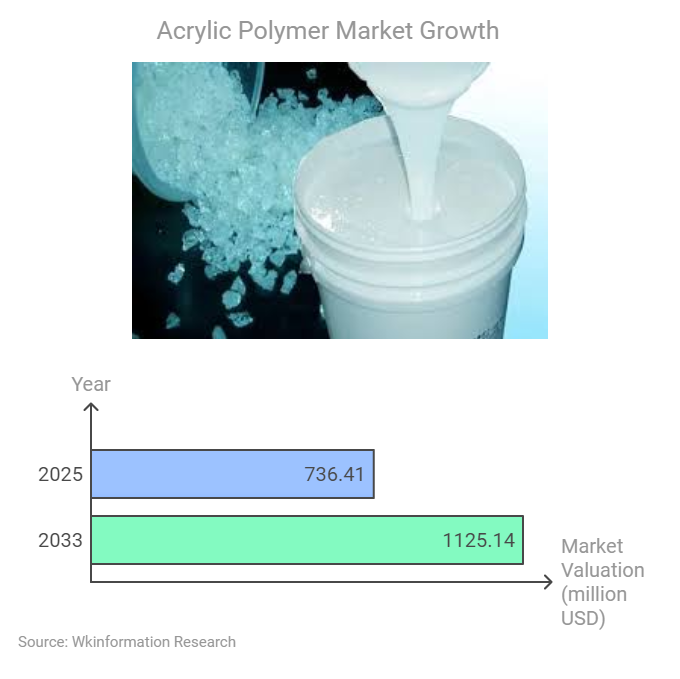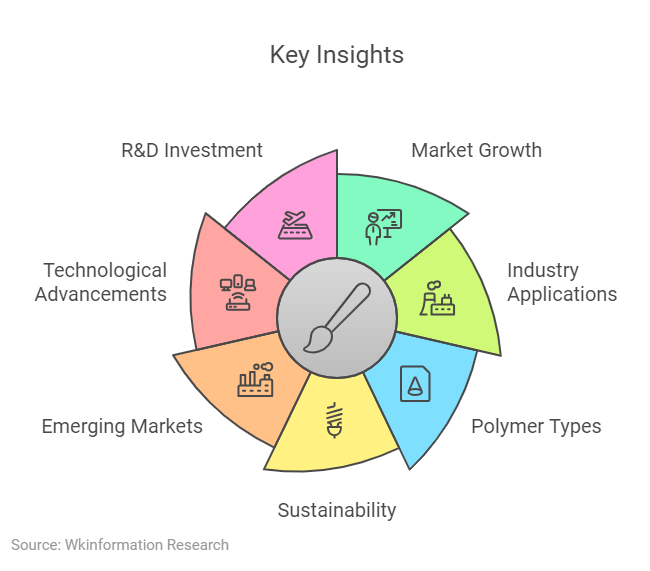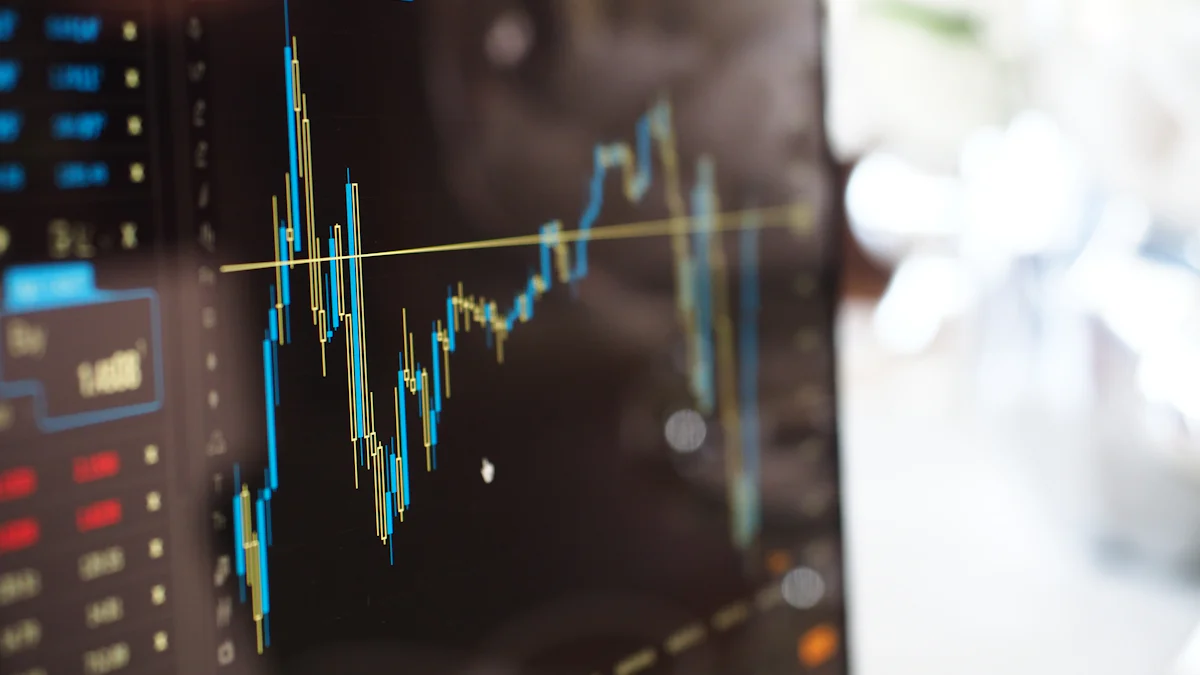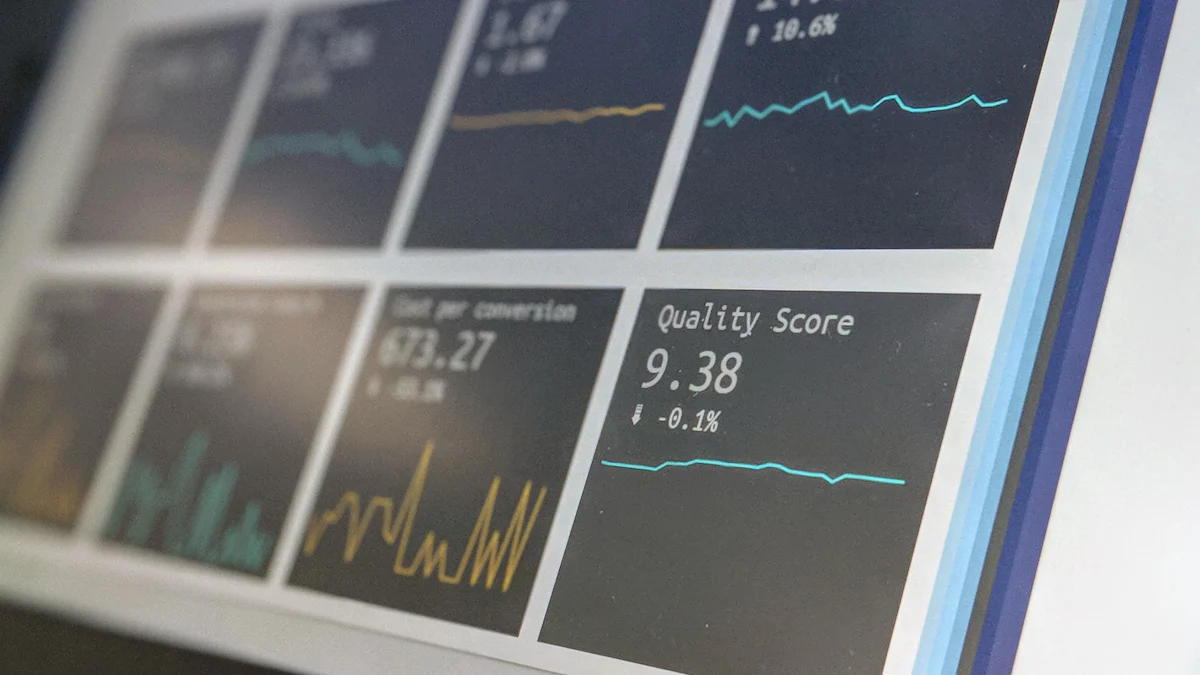
The global acrylic polymer market stands as a pivotal segment within the chemical industry, showcasing robust growth and dynamic trends. As of 2025, the market was valued at approximately USD 736.41 million, with projections indicating a rise to USD 1125.14 million by 2033. This growth reflects a compound annual growth rate (CAGR) of 5.44% from 2025 to 2033. The market size and market analysis reveal that acrylic polymers are integral to various sectors, including construction, automotive, and textiles. The key question remains: What are the future prospects of the acrylic polymer market?
Key Insights
- The global acrylic polymer market is projected to grow from USD 736.41 million in 2025 to USD 1125.14 million by 2033, with a CAGR of 5.44%.
- Acrylic polymers are essential in various industries, including construction, automotive, and textiles, due to their versatility and performance characteristics.
- Thermoplastic acrylic polymers can be reshaped multiple times, making them ideal for coatings and adhesives, while thermosetting types provide durability for high-heat applications.
- Sustainability is a key focus, with companies innovating to develop eco-friendly acrylic polymers that meet regulatory standards and consumer preferences.
- Emerging markets, particularly in Asia-Pacific and Latin America, present significant growth opportunities driven by industrialization and urbanization.
- Technological advancements are enhancing the properties of acrylic polymers, leading to new applications and increased market demand.
- Stakeholders should invest in research and development to stay competitive and capitalize on the growing demand for high-performance materials.

Acrylic Polymer Market Overview
The acrylic polymer market plays a crucial role in various industries due to its versatile nature and wide range of applications. Acrylic polymers, synthetic resins derived from acrylic acid or its derivatives, are known for their transparency and rigidity. These properties make them indispensable in sectors such as construction, automotive, and textiles.
Types of Acrylic Polymers
Acrylic polymers can be categorized into two main types based on their chemical structure and application requirements:
Thermoplastic Acrylic Polymers
Thermoplastic acrylic polymers are characterized by their ability to be melted and reshaped multiple times without undergoing any chemical change. This property makes them highly adaptable for various applications, including coatings and adhesives. Their flexibility and ease of processing contribute significantly to the growth of the acrylic polymer market.
Thermosetting Acrylic Polymers
In contrast, thermosetting acrylic polymers undergo a chemical change when heated, resulting in a rigid and durable structure. Once set, they cannot be remelted or reshaped. These polymers are ideal for applications requiring high heat resistance and structural integrity, such as in automotive parts and construction materials.
Applications of Acrylic Polymers
The acrylic polymer market thrives due to its extensive applications across different sectors. Some of the key applications include:
Paints and Coatings
Acrylic polymers are integral to the paints and coatings industry. They offer durability, weather resistance, and color retention, making them suitable for both interior and exterior applications. The demand for acrylic polymers in this segment continues to rise, contributing significantly to the overall market revenue.
Adhesives and Sealants
In the adhesives and sealants sector, acrylic polymers provide excellent adhesion properties and UV stability. These characteristics make them essential for use in construction and automotive industries, where strong and reliable bonding is crucial.
Textiles and Fibers
Acrylic polymers are also widely used in the textiles and fibers industry. Their chemical purity, stability, and resistance to sunlight and weathering enhance the performance and durability of textile products. This versatility further fuels the expansion of the acrylic polymer market.
The acrylic polymer market is poised for continued growth, driven by its diverse applications and the increasing demand for high-performance materials across various industries.
Acrylic Polymer Market Dynamics
The acrylic polymer market exhibits dynamic characteristics driven by various factors. Understanding these dynamics is crucial for stakeholders aiming to capitalize on market opportunities and navigate potential challenges.
Growth Drivers
Increasing Demand in Construction
The construction industry significantly contributes to the market growth of acrylic polymers. These polymers offer durability, weather resistance, and aesthetic appeal, making them ideal for construction applications. As urbanization accelerates globally, the demand for high-performance materials in infrastructure projects rises. This trend fuels the growth of the acrylic polymer market, as builders and architects increasingly rely on these materials for their projects.
Rising Use in Automotive Industry
The automotive sector also plays a pivotal role in driving the acrylic polymer market. Acrylic polymers are used extensively in automotive parts due to their lightweight nature and excellent mechanical properties. As the automotive industry shifts towards more fuel-efficient and environmentally friendly vehicles, the demand for lightweight materials like acrylic polymers increases. This shift supports the market growth and underscores the importance of acrylic polymers in modern automotive manufacturing.
Market Restraints
Environmental Concerns
Environmental concerns pose significant challenges to the acrylic polymer market. The production and disposal of acrylic polymers raise issues related to sustainability and environmental impact. Regulatory bodies impose stringent guidelines to mitigate these effects, which can hinder market expansion. Companies must innovate and adopt eco-friendly practices to address these concerns and maintain their competitive edge.
Fluctuating Raw Material Prices
The volatility of raw material prices presents another restraint for the acrylic polymer market. Fluctuations in the cost of raw materials, such as acrylic acid, can impact production costs and pricing strategies. This unpredictability necessitates strategic planning and risk management to ensure profitability and market stability.
Opportunities
Innovations in Product Development
Innovations in product development offer promising opportunities for the acrylic polymer market. Advances in technology enable the creation of new polymer formulations with enhanced properties. These innovations cater to emerging applications and meet the evolving needs of various industries. Companies investing in research and development can leverage these opportunities to expand their product portfolios and capture new market segments.
Expansion in Emerging Markets
Emerging markets present significant growth opportunities for the acrylic polymer market. Rapid industrialization and urbanization in regions such as Asia-Pacific and Latin America drive the demand for acrylic polymers. Companies that strategically expand their presence in these regions can benefit from the increasing demand and establish a strong foothold in the global market.
Regional Analysis of the Acrylic Polymer Market

North America
North America’s acrylic polymer market is experiencing significant growth, driven by a robust industrial base and increasing consumer demand. The region’s chemical industry is projected to grow by 3.2% in 2024, reflecting a strong foundation for the acrylic polymer sector. The United States, with its substantial construction spending of approximately USD 1.8 trillion in 2024, plays a pivotal role in this expansion. The construction industry’s demand for durable and versatile materials fuels the market’s growth. Additionally, advancements in automotive manufacturing, emphasizing lightweight and efficient materials, further bolster the market’s performance in North America.
Europe
Europe’s acrylic polymer market showcases steady growth, supported by the region’s focus on sustainability and innovation. European industries prioritize eco-friendly materials, driving the demand for acrylic polymers known for their environmental benefits. The region’s stringent regulations on emissions and waste management encourage the adoption of sustainable practices, positioning acrylic polymers as a preferred choice. Furthermore, Europe’s automotive sector, renowned for its technological advancements, integrates acrylic polymers to enhance vehicle performance and reduce environmental impact. This alignment with sustainability trends ensures the continued growth of the acrylic polymer market in Europe.
Asia-Pacific
Asia-Pacific emerges as a dominant force in the acrylic polymer market, propelled by rapid industrialization and urbanization. The region’s GDP growth of 4.8% in 2024 underscores its economic vitality, creating a fertile ground for market expansion. Countries like India and China lead the charge with significant industrial production increases, contributing to the market’s robust performance. The construction sector, driven by infrastructure development, demands high-performance materials, further boosting the market. Additionally, the expanding automotive industry in Asia-Pacific, with its focus on innovation and efficiency, amplifies the demand for acrylic polymers. This dynamic growth trajectory positions Asia-Pacific as a key player in the global acrylic polymer market.
Rest of the World
The acrylic polymer market in regions outside North America, Europe, and Asia-Pacific demonstrates unique growth patterns and opportunities. Latin America and the Middle East & Africa, in particular, are witnessing notable developments driven by industrialization and infrastructure projects.
- Latin America: The region’s acrylic polymer market benefits from increasing construction activities and industrial growth. Countries like Brazil and Mexico are investing heavily in infrastructure, which boosts the demand for durable materials such as acrylic polymers. The automotive industry also contributes to market expansion, with manufacturers seeking lightweight and efficient materials to enhance vehicle performance.
- Middle East & Africa: The acrylic polymer market in this region is influenced by rapid urbanization and economic diversification efforts. Governments are investing in large-scale construction projects, including residential, commercial, and industrial developments. These initiatives create a robust demand for acrylic polymers, known for their versatility and durability. Additionally, the region’s focus on sustainability and eco-friendly materials aligns with the growing preference for acrylic polymers in various applications.
- Australia and New Zealand: These countries exhibit steady growth in the acrylic polymer market, driven by advancements in the construction and automotive sectors. The emphasis on sustainable building practices and energy-efficient vehicles supports the adoption of acrylic polymers. The market’s expansion is further fueled by technological innovations and the development of new polymer formulations tailored to meet specific industry needs.
Overall, the rest of the world presents diverse opportunities for the acrylic polymer market. The combination of industrial growth, infrastructure development, and a shift towards sustainable materials positions these regions as emerging players in the global market landscape.
Competitive Landscape in the Acrylic Polymer Market
The competitive landscape of the acrylic polymer market is shaped by several key players who drive innovation and growth. These companies employ various strategies to maintain their market positions and expand their influence globally.
Major Players in the Market
Evonik
Evonik stands as a leading player in the acrylic polymer market, renowned for its commitment to innovation and sustainability. The company focuses on developing high-performance polymers that cater to diverse industrial needs. Evonik’s strategic investments in research and development enable it to introduce cutting-edge products that meet the evolving demands of the market.
DuPont
DuPont, a prominent name in the chemical industry, plays a significant role in the acrylic polymer market. The company’s extensive portfolio includes a wide range of acrylic polymers used in various applications. DuPont emphasizes sustainability and eco-friendly solutions, aligning its products with global environmental standards. This approach not only enhances its market reputation but also attracts environmentally conscious consumers.
Lucite International
Lucite International, a subsidiary of Mitsubishi Chemical Corporation, is a key player in the acrylic polymer market. The company specializes in the production of high-quality acrylic polymers, serving industries such as construction, automotive, and textiles. Lucite International’s focus on quality and customer satisfaction has solidified its position as a trusted supplier in the market.
Strategies Adopted by Key Players
Mergers and Acquisitions
Mergers and acquisitions serve as a crucial strategy for major players in the acrylic polymer market. Companies like Evonik and DuPont actively pursue acquisitions to expand their product portfolios and enhance their market presence. These strategic moves allow them to access new markets and leverage synergies, ultimately driving growth and competitiveness.
Product Innovations
Product innovation remains a cornerstone strategy for success in the acrylic polymer market. Leading companies invest heavily in research and development to create innovative polymer formulations with enhanced properties. These innovations cater to emerging applications and address industry-specific challenges. By continuously introducing new and improved products, companies can capture new market segments and strengthen their competitive edge.
The acrylic polymer market continues to evolve, driven by the efforts of major players who prioritize innovation and strategic growth. Their commitment to sustainability and technological advancements ensures the market’s dynamic nature and promising future.
Future Trends and Forecast in the Acrylic Polymer Market

The acrylic polymer market is poised for significant advancements and growth in the coming years. Industry experts anticipate several key trends that will shape the market’s trajectory, driven by technological innovations and sustainability initiatives.
Projected Market Developments
Technological Advancements
Technological advancements play a crucial role in the evolution of the acrylic polymer market. Companies are investing heavily in research and development to enhance the properties of acrylic polymers. These advancements focus on improving durability, flexibility, and environmental compatibility. For instance, Evonik Industries AG recently introduced a new line of high-performance acrylic polymers designed for sustainable packaging applications. This innovation emphasizes recyclability and environmental compatibility, aligning with the growing demand for eco-friendly materials.
Sustainability Initiatives
Sustainability initiatives are becoming increasingly important in the acrylic polymer market. Companies are prioritizing the development of environmentally friendly products to meet regulatory requirements and consumer preferences. The shift towards sustainable materials is driving the adoption of acrylic polymers in various industries. These polymers offer a balance between performance and environmental impact, making them a preferred choice for manufacturers seeking to reduce their carbon footprint.
Market Forecast for the Next 5 Years
Expected Growth Rates
The acrylic polymer market is expected to experience robust growth over the next five years. Analysts forecast a compound annual growth rate (CAGR) of approximately 5.44% from 2025 to 2033. This growth is driven by increasing demand across multiple sectors, including construction, automotive, and textiles. The market’s expansion reflects the rising need for high-performance materials that offer durability and versatility.
Emerging Applications
Emerging applications present exciting opportunities for the acrylic polymer market. As industries continue to innovate, new uses for acrylic polymers are being discovered. In the automotive sector, for example, the demand for lightweight materials is driving the adoption of acrylic polymers in vehicle manufacturing. Additionally, the construction industry is exploring the use of these polymers in sustainable building materials. These emerging applications are expected to contribute significantly to the market’s growth and diversification.
The future of the acrylic polymer market looks promising, with technological advancements and sustainability initiatives paving the way for continued expansion. Companies that embrace these trends and invest in innovation are well-positioned to capitalize on the market’s potential.
Overview
The acrylic polymer market demonstrates significant growth potential, driven by technological innovations and sustainability initiatives. Key insights reveal the market’s expansion across various sectors, including construction, automotive, and textiles. The shift towards eco-friendly and bio-based acrylic polymers aligns with regulatory requirements and consumer preferences. Stakeholders should leverage these opportunities to capitalize on emerging trends and enhance their market presence. By investing in research and development, companies can stay ahead of the competition and contribute to a sustainable future.
| Report Attributes | Details |
|---|---|
| Base Year | 2024 |
| Market Size 2025 | 736.41 Million USD |
| Market Size 2033 | 1125.14 Million USD |
| CAGR | 5.44% |
| Historical Year | 2019 – 2024 |
| Forecast Year | 2025 – 2033 |
| Report Coverage | Revenue Forecast, Market Competitive Landscape, Growth Factors, and Trends |
| Segments Covered | Type, Applications, and Region |
| Geographies Covered | North America, Europe, Asia Pacific, and the Rest of the World |
FAQ
What are acrylic polymers?
Acrylic polymers are synthetic resins derived from acrylic acid or its derivatives. They are known for their transparency, rigidity, and versatility, making them essential in various industries such as construction, automotive, and textiles.
What are the main types of acrylic polymers?
Acrylic polymers can be categorized into two main types:
- Thermoplastic Acrylic Polymers: These can be melted and reshaped multiple times without undergoing any chemical change.
- Thermosetting Acrylic Polymers: These undergo a chemical change when heated, resulting in a rigid and durable structure that cannot be remelted or reshaped.
What are the key applications of acrylic polymers?
Acrylic polymers have extensive applications across different sectors, including:
- Paints and Coatings: Offering durability, weather resistance, and color retention.
- Adhesives and Sealants: Providing excellent adhesion properties and UV stability.
- Textiles and Fibers: Enhancing performance and durability of textile products.
What drives the growth of the acrylic polymer market?
Several factors drive the growth of the acrylic polymer market:
- Increasing Demand in Construction: Due to their durability and weather resistance.
- Rising Use in Automotive Industry: For lightweight and efficient materials.
- Innovations in Product Development: Creating new polymer formulations with enhanced properties.
- Expansion in Emerging Markets: Driven by rapid industrialization and urbanization.
What are the main challenges faced by the acrylic polymer market?
The acrylic polymer market faces several challenges:
- Environmental Concerns: Related to the production and disposal of acrylic polymers.
- Fluctuating Raw Material Prices: Impacting production costs and pricing strategies.
How do technological advancements impact the acrylic polymer market?
Technological advancements play a crucial role in the evolution of the acrylic polymer market. Companies invest heavily in research and development to enhance the properties of acrylic polymers, focusing on improving durability, flexibility, and environmental compatibility.
What are the future trends in the acrylic polymer market?
Future trends in the acrylic polymer market include:
- Technological Advancements: Enhancing the properties of acrylic polymers.
- Sustainability Initiatives: Developing environmentally friendly products to meet regulatory requirements and consumer preferences.
- Emerging Applications: New uses for acrylic polymers in industries such as automotive and construction.
Who are the major players in the acrylic polymer market?
Some of the major players in the acrylic polymer market include:
- Evonik: Known for its commitment to innovation and sustainability.
- DuPont: Emphasizing sustainability and eco-friendly solutions.
- Lucite International: Specializing in high-quality acrylic polymers for various industries.
What strategies do key players adopt in the acrylic polymer market?
Key players in the acrylic polymer market adopt several strategies, including:
- Mergers and Acquisitions: To expand product portfolios and enhance market presence.
- Product Innovations: Investing in research and development to create innovative polymer formulations with enhanced properties.
What is the market forecast for the acrylic polymer market over the next five years?
Analysts forecast a compound annual growth rate (CAGR) of approximately 5.44% from 2025 to 2033. This growth is driven by increasing demand across multiple sectors, including construction, automotive, and textiles. Emerging applications and sustainability initiatives are expected to contribute significantly to the market’s growth and diversification.
Global Acrylic Polymer Market Report – Table of Contents
1 Market Study Overview
2 Basic Product Information
3 Market Analysis
4 Acrylic Polymer Related Market Analysis
5 Global Trend Summary
6 Competition by Manufacturer
7 Analysis of Key Players
8 Global Acrylic Polymer Revenue, Sales Categorized by Regions
9 North America Acrylic Polymer Market Size Categorized by Countries
10 Europe Acrylic Polymer Market Size Categorized by Countries
11 Asia-pacific Acrylic Polymer Market Size Categorized by Countries
12 South America Acrylic Polymer Market Size Categorized by Countries
13 Middle East and Africa Acrylic Polymer Market Size Categorized by Countries
14 Global Acrylic Polymer Industry Segment Analysis
15 Global Acrylic Polymer Market Forecast
16 Research Findings and Conclusion
17 Appendix


